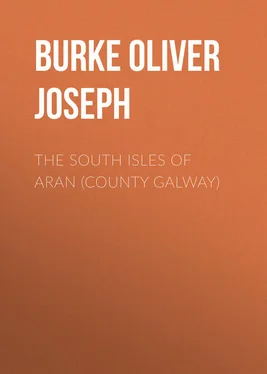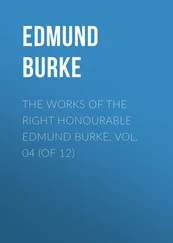Oliver Burke - The South Isles of Aran (County Galway)
Здесь есть возможность читать онлайн «Oliver Burke - The South Isles of Aran (County Galway)» — ознакомительный отрывок электронной книги совершенно бесплатно, а после прочтения отрывка купить полную версию. В некоторых случаях можно слушать аудио, скачать через торрент в формате fb2 и присутствует краткое содержание. ISBN: , Жанр: foreign_antique, foreign_prose, на английском языке. Описание произведения, (предисловие) а так же отзывы посетителей доступны на портале библиотеки ЛибКат.
- Название:The South Isles of Aran (County Galway)
- Автор:
- Жанр:
- Год:неизвестен
- ISBN:http://www.gutenberg.org/ebooks/37840
- Рейтинг книги:4 / 5. Голосов: 1
-
Избранное:Добавить в избранное
- Отзывы:
-
Ваша оценка:
- 80
- 1
- 2
- 3
- 4
- 5
The South Isles of Aran (County Galway): краткое содержание, описание и аннотация
Предлагаем к чтению аннотацию, описание, краткое содержание или предисловие (зависит от того, что написал сам автор книги «The South Isles of Aran (County Galway)»). Если вы не нашли необходимую информацию о книге — напишите в комментариях, мы постараемся отыскать её.
The South Isles of Aran (County Galway) — читать онлайн ознакомительный отрывок
Ниже представлен текст книги, разбитый по страницам. Система сохранения места последней прочитанной страницы, позволяет с удобством читать онлайн бесплатно книгу «The South Isles of Aran (County Galway)», без необходимости каждый раз заново искать на чём Вы остановились. Поставьте закладку, и сможете в любой момент перейти на страницу, на которой закончили чтение.
Интервал:
Закладка:
The South Isles of Aran (County Galway)
My dear Judge O'Hagan,
During the vacation of last autumn I applied myself to collecting as much information as possible concerning the South Isles of Aran, which I had visited in connection with the Land Commission in the previous month of July. Pressure of business and a severe illness compelled me to defer until recently the arranging of my notes, which, in the hope that they may direct the attention of those in power to the long neglected Islands, I have resolved to publish, and I look on it as a good omen of the success of my efforts that you have kindly allowed me to dedicate my work to you, who have won so high a place in law and in literature.
Believe me to remain Sincerely yours, OLIVER J. BURKE.Ower, Headford,
Co. Galway,
August 8, 1887 .
CHAPTER I
"Oh, Aranmore! loved Aranmore,
How oft I dream of thee,
And of those days when by thy shore
I wandered young and free;
Full many a path I've tried since then,
Through pleasure's flowery maze,
But ne'er could find the bliss again
I felt in those sweet days."
POPE GREGORY THE GREAT
The south isles of Aran, which shelter the Galway bay from the heavy swell of the Atlantic, are Inishmore, the large island, nine miles in length; Inishmaan, the middle island, two and a half miles in length; Inisheer, the lesser, two miles in length; Straw Island, upon which the lighthouse stands, and the Brannock Rocks or islands, all forming that group which to the west bounds the Galway bay, and the ancient jurisdiction of the Admiral of Galway. They lie in a line drawn from the north-west to the south-east from Iar Connaught to the county of Clare. Iar Connaught is separated from Inishmore, the largest and most westerly island, by the North Sound, five and a half miles wide, called by the natives Bealagh-a-Lurgan , "Lough Lurgan way." Lough Lurgan was the ancient name of a lake that formerly lay west of Galway, and the tradition is that in the old times before us – 213 years from the Flood – the waters of the Atlantic, sweeping in the full fury of their force across the Aran barriers, united with the waters of the lake and formed the Bay of Galway, leaving the islands of Aran the towering remnants of the barriers which were too strong even for the Atlantic billows to carry away. Between Inishmore and Inishmaan is Gregory's Sound, a mile and a half wide, called by the natives Bealagh-ne-Hayte , "Hayte's way." The present name was given to it by the monks, who called the sound "Gregory," in honour of Pope Gregory the Great, after he had converted or aided in converting the Anglo-Saxons to the Christian faith. Between the middle island, Inishmaan, and Inisheer, the eastern and smallest island, is the "foul sound," four miles wide; and between Inisheer and the county of Clare is the "south sound," four miles wide. This is the great waterway between "the old sea," as the natives call the Atlantic, and the Bay of Galway.
MANOR OF IAR CONNAUGHT.
The sum of the lengths of the three islands and of the two intervening sounds is eighteen miles. The area of the entire group is 11,288 acres; poor law valuation, £1576; rent, £2067; poor rate, a shilling in the pound; average poor rate for ten years, three shillings; population, 3118 Catholics, and 45 Protestants. Aran is in the Catholic archdiocese and in the Protestant diocese of Tuam. In the islands are three Catholic churches and one Protestant, two priests, one parson, and one doctor, and there are schools, schoolmasters, schoolmistresses, and scholars, et hoc genus omne ; and there is a petty sessions court, and there are three police-barracks and eighteen policemen. The fishing-boats or curraghs of the third class, which are ribs covered with canvas, and worth £6 each, are 130 in number; of the second class there are 34 boats, and of the first class there are none. There are no paupers from the islands in the workhouse, which is in Galway, and there is no workhouse on the island; neither is there an auxiliary workhouse, nor an hospital, nor an infirmary, nor a midwife, nor a jail, nor grand jury works, though there is a grand jury cess of £34 12 s. 2 d.
THE ARAN MAIL-BOAT.
Of Inishmore, or the great island, Kilronan is the capital – a village with a good hotel. Killeany was the ancient capital, formerly the residence of the lords of the manor of Iar Connaught. The other places of note are Oghil, Onaght, Bungowla, Kilmurry, Dun Ængus, Dun Eochla, Dubh Chathair or the black fort. So also on that island are the ruins of the churches of Tempul Benin with its rectangular enclosures and group of cells, of Tempul Brecan and Cross, of Tempul Beg Mac Dara, of Tempul More Mac Dara, of Tempul Assurniadhe, of Tempul-an-cheathrair-Aluin, and of St. Enda and the ruins of the seven churches.
On the middle island of Inishmaan are the ruins of the fortresses of Dun Chona and Dunfarbagh, and the villages, five in number. On the eastern island of Inisheer are St. Gobnet's chapel, Ballyhees, Largi, Furmina, Trawkera, near which there is a lake a quarter of a mile in circumference and of great depth, which might be converted into a useful harbour by cutting an entrance into it through the rocky shore.
The harbour of Kilronan is spacious, but not fitted for vessels of heavy tonnage. A pier of four or five hundred yards is built out into the sea, alongside of which was moored during the tempestuous days of the last week of July (1886) her Majesty's mail-boat – a large-sized sailing yacht, provided with a cabin and forecastle, and manned by a remarkably civil and obliging crew. But it is to be lamented that no steamer has as yet been placed on the line between Galway and Aran, in consequence of which, frequently for four or five days, communication with the mainland becomes impossible. Letters remained unanswered, and newspapers remained unread; so that nation might rise against nation, and kingdom against kingdom, but the islanders in happy repose, undisturbed by the postman or by the magnetic wire, would in their isles of peace have happily lived on in blissful ignorance of the painful turmoils that reigned around.
THE BLACK-EYED HEBÈ.
At the hotel the tourist will be served with a homely and wholesome fare – prime veal and sweet and tender mutton, for the Aran herbage is renowned for the tenderness of the meat that it produces. At dinner a bottle of the mountain-dew, with a smell as divine as it is illegal, may be by accident produced; and for all this, when the guest requests that he might be informed of the charges, the reply ten to one will be, "Oh, anything your honour likes to give!" – at least, such was said by the black-eyed Hebè who ministered to the wants of the writer of these pages.
THE FLORA OF ARAN.
The Aran landscape as your vessel approaches from Galway is a peculiar one – peculiar to Aran. From the soft sea beach on the Galway side of the island, which varies in breadth from one to four miles across, slope fields of bare rocks terrace over terrace, sometimes nine in number, until they reach the topmost cliff on the south-west or ocean side hundreds of feet over the Atlantic. This terraced landscape has the appearance of being a barren and rocky wilderness; but on closer inspection threads of fresh green herbages can be traced in the cleavages and deeply cut fissures of the rocks, and it is in those cleavages that the richest profusion of botanical specimens are to be found. The cleft upon which we stood was teeming with purple heather, foxglove, scarlet geranium, and wild thyme, with the golden leaf of the variegated ivy; the crimson berries of the orchis and the red fruit of the wild strawberry forming a rich contrast to the delicate blue of the forget-me-not.
Читать дальшеИнтервал:
Закладка:
Похожие книги на «The South Isles of Aran (County Galway)»
Представляем Вашему вниманию похожие книги на «The South Isles of Aran (County Galway)» списком для выбора. Мы отобрали схожую по названию и смыслу литературу в надежде предоставить читателям больше вариантов отыскать новые, интересные, ещё непрочитанные произведения.
Обсуждение, отзывы о книге «The South Isles of Aran (County Galway)» и просто собственные мнения читателей. Оставьте ваши комментарии, напишите, что Вы думаете о произведении, его смысле или главных героях. Укажите что конкретно понравилось, а что нет, и почему Вы так считаете.












